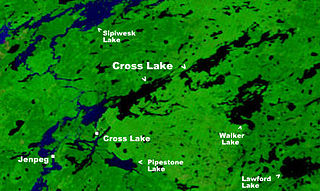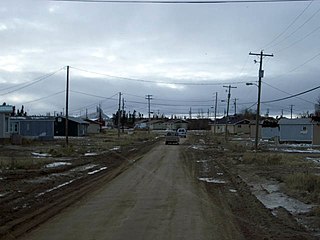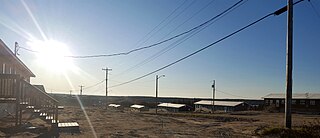
The Cree are a North American Indigenous people. They live primarily in Canada, where they form one of the country's largest First Nations.
In Canada, an Indian reserve is specified by the Indian Act as a "tract of land, the legal title to which is vested in Her Majesty, that has been set apart by Her Majesty for the use and benefit of a band." Indian reserves are the areas set aside for First Nations, an indigenous Canadian group, after a contract with the Canadian state, and are not to be confused with land claims areas, which involve all of that First Nations' traditional lands: a much larger territory than any reserve.
A tribal council is an association of First Nations bands in Canada, generally along regional, ethnic or linguistic lines.
First Nations in Alberta are a group of people who live in the Canadian province of Alberta. The First Nations are peoples recognized as Indigenous peoples or Plains Indians in Canada excluding the Inuit and the Métis. According to the 2011 Census, a population of 116,670 Albertans self-identified as First Nations. Specifically there were 96,730 First Nations people with registered Indian Status and 19,945 First Nations people without registered Indian Status. Alberta has the third largest First Nations population among the provinces and territories. From this total population, 47.3% of the population lives on an Indian reserve and the other 52.7% live in urban centres. According to the 2011 Census, the First Nations population in Edmonton totalled at 31,780, which is the second highest for any city in Canada. The First Nations population in Calgary, in reference to the 2011 Census, totalled at 17,040. There are 48 First Nations or "bands" in Alberta, belonging to nine different ethnic groups or "tribes" based on their ancestral languages.
Treaty Five is a treaty that was first established in September, 1875, between Queen Victoria and Saulteaux and Swampy Cree non-treaty band governments and peoples around Lake Winnipeg in the District of Keewatin. Much of what is today central and northern Manitoba was covered by the treaty, as were a few small adjoining portions of the present-day provinces of Saskatchewan and Ontario. The Treaty was completed in two rounds. The first was from September 1875 to September 1876. The Crown intended in 1875 to include only "the Indians [east and west] of Lake Winnipeg for the surrender of the Territory uncovered by previous treaties" including "the proposed migration of the Norway House band". Pimicikamak territory was north of the lake. It was included by accident or design of Tepastenam attending the Norway House signing. Additional peoples and groups signed on between 1908 and 1910.
Indigenous police services in Canada are police forces under the control of a First Nation or Inuit government. The power of Indigenous governments to establish independent police services varies, and only First Nations and Inuit communities governed by the Indian Act can establish their own police forces. Métis governments, First Nations, and Inuit governments that have completed the comprehensive land claims process can only contract police services to a third party police force. The powers of Indigenous police services also vary, and some cannot complete criminal investigations without outside consultation or maintain specialized resources, such as police dogs or crime labs.

Cross Lake is the name of two closely related, adjoining but independent communities in the Canadian province of Manitoba. One of the Cross Lakes is the Cross Lake Indian Reserve of the Cross Lake First Nation where the main urban area is called Cross Lake. The other Cross Lake is on nearby provincial Crown land. The communities are located about 520 kilometres by air north of Winnipeg, and 120 kilometres by air south of Thompson. They are situated on the shores of the Nelson River where the river enters Cross Lake. An all-weather road, PR 374, connects the communities to PR 373 via the Kichi Sipi Bridge.

Treaty 4 is a treaty established between Queen Victoria and the Cree and Saulteaux First Nation band governments. The area covered by Treaty 4 represents most of current day southern Saskatchewan, plus small portions of what are today western Manitoba and southeastern Alberta. This treaty is also called the Qu'Appelle Treaty, as its first signings were conducted at Fort Qu'Appelle, North-West Territories, on 15 September 1874. Additional signings or adhesions continued until September 1877. This treaty is the only indigenous treaty in Canada that has a corresponding indigenous interpretation.
Oxford House is a First Nations Cree community in northern Manitoba, located on the Oxford House 24 Indian reserve. The community is located along the eastern shore of Oxford Lake at the mouth of Hayes River, 950 kilometres (590 mi) north of Winnipeg. The Hayes River was designated a Canadian Heritage River in 2006.

Split Lake, or Tataskwayak, is a community in Manitoba on the northern short of Split Lake along the Nelson River, about 240 mi (390 km) west southwest of the river's mouth at Hudson Bay, and is within the Tataskweyak Cree Nation reserve, Split Lake 171. The community is located 143 km (89 mi) northeast of Thompson, roughly the halfway point of PR 280 in Northern Manitoba, and 169 km (105 mi) west of Gillam.

Peguis First Nation is the largest First Nations community in Manitoba, Canada, with a population of approximately 10,300 people. The members of Peguis are of Saulteaux (Ojibway) and Cree descent.
Cross Lake First Nation is a band of Cree First Nations people in Canada governed under the Indian Act. Its members occupy several reserves within the town of Cross Lake situated on the east shore of Cross Lake in the province of Manitoba. In October 2008, its recorded registered membership was 6,969, of which 4,953 people of this First Nation lived on their reserve. Cross Lake is the principal community of the Pimicikamak indigenous people that made treaty with the British Crown in 1875. Its indigenous language is Woods Cree. Cross Lake was the site of a residential school operated under Canada's assimilation policy. In 2008, Prime Minister Stephen Harper apologized for the damage caused by this policy.

Ahtahkakoop First Nation is a Cree First Nation band government in Shell Lake, Saskatchewan, Canada. The Ahtahkakoop First Nation government and community is located on Ahtahkakoop 104, 72 kilometers northwest of Prince Albert and is 17,347 hectares in size. The community was formerly known as the "Sandy Lake Indian Band", a name which is still used interchangeably when referring to the reserve.
Pimicikamak is the name of one of the Cree-speaking aboriginal peoples of Canada. Pimicikamak is "a people of rivers and lakes. The traditional territory of Pimicikamak is around Sipiwesk Lake in the heart of the boreal forest, five hundred kilometres north of Winnipeg, Manitoba. Flowing through their land is Kichi Sipi, the Great River." Pimicikamak's traditional territory also is known as Pimicikamak.

Marcel Colomb First Nation (MCFN), Band #328, is a First Nations Band of approximately 449 Registered Swampy Cree and Rocky Cree (Asinīskāwiyiniwak) located in the area of Lynn Lake, Manitoba, Canada. Marcel Colomb First Nation is affiliated with the Swampy Cree Tribal Council.
The Mathias Colomb Cree Nation (MCCN) —also known as Mathias Colomb First Nation, Mathias Colomb (Cree) First Nation, and Pukatawagan/Mathias Colomb Cree Nation—is a remote First Nations community in northern Manitoba, located 210 km (130 mi) north of The Pas and 819 km (509 mi) northwest of Winnipeg, Manitoba.
The Norway House Cree Nation is based at Norway House, Manitoba, which is located on the Playgreen Lake section of the Nelson River system. The people are Swampy Cree from the Rocky Cree (Asinīskāwiyiniwak) band government. They are in possession of a number of reserves, but population is centered at IR Norway House 17 (06392). There are over 8300 members living on-reserve with another 1900 plus members at various locations off-reserve. The 2016 Census reported an official population of 7,927 inhabitants at Norway House 17 up from 4 7,758 in 2011.

The Sapotaweyak Cree Nation is a First Nations band government whose reserves are located in northern Manitoba, north-east of Swan River, approximately 400 kilometres northwest of Winnipeg.
Saddle Lake Cree Nation is a Plains Cree, First Nations community, located in the Amiskwacīwiyiniwak region of central Alberta, Canada. The Nation is a signatory to Treaty 6, and their traditional language is Plains Cree.
Indigenous or Aboriginal self-government refers to proposals to give governments representing the Indigenous peoples in Canada greater powers of government. These proposals range from giving Aboriginal governments powers similar to that of local governments in Canada to demands that Indigenous governments be recognized as sovereign, and capable of "nation-to-nation" negotiations as legal equals to the Crown, as well as many other variations.








